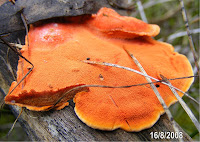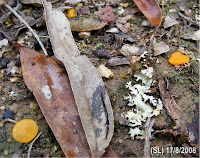During a couple of lulls between rain periods last night, I took my camera for a bit of a walk around the traps!
(Click to enlarge)

This is Neobatrachus sudelli (Common Spadefoot Toad) You can see how common this one is because it's wearing some dinner on its head! :-) The loose skin along the side of the body to the knee is characteristic of this species as well as the vertical pupil and absence of tibial glands. Also, there appears to be a mite-like insect in the l/h side of the eye. Males of this species generally call from February to November.

Here we have Limnodynastes dumerili (Pobblebonk or Banjo Frog) I expected to see more than one of this common species. Males call almost all year round, but they have been a bit quiet here, so far.
Apart from Litoria Ewingi, I've been listening to Limndynastes tasmaniensis (Spotted Marsh Frog) calling with its distinct kuk-kuk-kuk or a sound like two stones being hit together. Also, Ranidella signifera (Common Froglet) which has the typical crik crik crik crik call. I actually found one under a log when I was doing a bit of fencing down on the dam the other day. Of course, the camera was NOT in the Ute!! :-)

















































